1. What is Yayoi? The Meaning and Origin of the Japanese Name for March
The Japanese name for March, "Yayoi" is a beautiful word that symbolizes the changing of the seasons in Japan. "Yayoi" means "the grass and trees are increasingly lush," representing the arrival of spring, when life begins to sprout and nature comes alive. Additionally, the character "弥" carries the meaning of "more and more" or "increasing," evoking the sense of winter’s end and the vigorous growth of plants and flowers.
During this time, cherry blossoms and rapeseed flowers begin to bloom, marking an important turning point that announces the arrival of spring.
Cherry Blossoms Begin to Bloom Everywhere
The yellow flowers of
2. Differences Between Yayoi and the Old and New Calendars
The Japanese name "Yayoi" originally referred to the third month of the lunar calendar (old calendar). In the old lunar calendar (lunar-solar calendar), it corresponds to what we now know as April, meaning that the actual "Yayoi" was a bit warmer. However, with the shift to the new calendar (current solar calendar), Yayoi now falls in March, strengthening its association with the "beginning of spring." Consequently, when old calendar events are celebrated in March of the new calendar, there can be discrepancies in climate.
3. The History of Yayoi and Japanese Culture | Influences from the Manyoshu and the Yayoi Period
▶ The Etymology of Yayoi and Classical Literature
The term "Yayoi" appears frequently in poetry and stories from the Heian period. For example, the poem by Fujiwara no Sadaie:
"In the spring night, the dream-like bridge ends,
parting at the peak, beneath the clouds in the sky."
This verse beautifully expresses the transience and change of spring, capturing the essence of the Yayoi season. Additionally, both "The Pillow Book" and "The Tale of Genji" depict the spring scenery of March, illustrating how the Heian aristocrats cherished the arrival of spring.
▶ The Relationship Between the Yayoi Period and March
When people hear "Yayoi," many may think of the "Yayoi Period." The Yayoi Period (around 300 BC to 300 AD) was an era in Japan marked by the development of agricultural culture, where people built lives in harmony with nature. While the term "Yayoi" is not directly related to this period, both share a common theme of "the beginning of agricultural activities with the arrival of spring."
4. Nature and Seasonal Customs in March | Cherry Blossoms, Rapeseed, and the Vernal Equinox
▶ Cherry Blossoms and Hanami
March marks the season when Japan's iconic flower, the "sakura" (cherry blossom), begins to bloom. Hanami (flower viewing) takes place across the country, and people revel in the arrival of spring.
• "Sakura Zensen": A marker indicating the blooming period of cherry blossoms moving northward across the Japanese archipelago.
• "Origin of Hanami": The custom originated from aristocratic parties during the Nara period.
▶ The Vernal Equinox and Connection to Nature
In March, the "Vernal Equinox" arrives, when day and night are nearly equal in length. This day is celebrated as "a day to honor nature and cherish living beings," making it a Japanese holiday. Historically, the Vernal Equinox marked the beginning of serious agricultural work, reflecting the Japanese spirit of coexistence with nature.
5. Hina Matsuri and Yayoi Culture | Traditional Events in March and Their Origins
March 3rd is the day of "Hina Matsuri" (Doll Festival). Hina Matsuri is a celebration wishing for the healthy growth of girls, which began in the Heian period and spread to the common people during the Edo period.
▶ The Meaning of Hina Dolls and Peach Blossoms
• Hina Dolls: They symbolize the warding off of evil and misfortune.
• Peach Blossoms: Believed to have the power to dispel negative energies.
Fun Fact: In ancient China, there was a custom of purifying oneself in rivers on March 3rd. This practice is said to have been brought to Japan, transformed into "nagashi bina" (flowing dolls), and developed into the current Hina Matsuri.
Hina Doll
Peach Blossom
6. How to Incorporate the Spirit of Yayoi into March Living
▶ Changes in Spring Living
• Changing Wardrobe: March experiences significant temperature fluctuations, making it a time to gradually transition from winter clothing to spring attire.
• Allergy Prevention: As cedar pollen becomes more prevalent, masks and air purifiers become essential.
• Seasonal Delicacies of Spring: Bamboo shoots, rapeseed, and wild vegetables are at their delicious peak during this time.
Spring Celebration Foods
Hina Matsuri → Chirashi sushi, clam soup, hina arare
Vernal Equinox Day → Botamochi (spring equinoctial week)
Chirashi sushi
Botamochi_A traditional dish made with vinegared rice and various toppings, often enjoyed during the spring equinoctial week.
Explore the charm of Japan's traditional spring event, Hina Matsuri
What is Ohigan?
Ohigan is a Buddhist observance in Japan, referring to a seven-day period centered around the Vernal and Autumnal Equinoxes, including three days before and after each equinox. The spring Ohigan is observed for seven days, with the Vernal Equinox as the central day, during which many people visit graves to express gratitude to their ancestors.
7. Summary | The Arrival of Spring as Conveyed by Yayoi
The Japanese name "Yayoi" symbolizes the sprouting of life and the arrival of spring. Understanding its meaning and origin can make March in Japan feel even more enchanting. As you glance around, you’ll notice the cherry blossom buds beginning to bloom. March liberates us from winter’s chill, and the gentle sunlight warms our hearts.
This spring, why not enjoy the arrival of the season while feeling the breeze of Yayoi?
● Introducing March in Japan Through Photos
• Flowers and Plants Seen in March:
• Flowers and Plants Seen in March:
• Graduation ceremonies are held in March in Japan.
• Sakura mochi sprinkled with pickled cherry blossoms.












